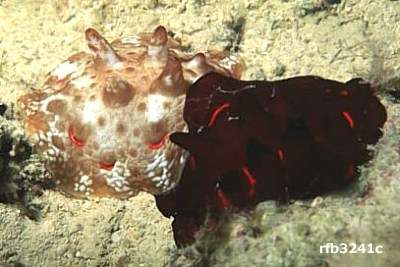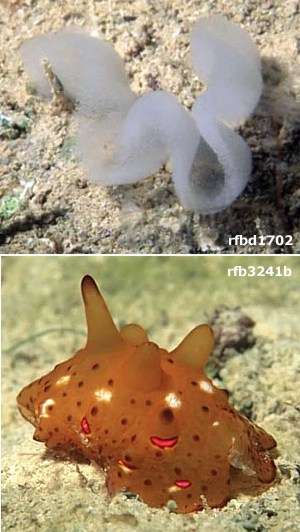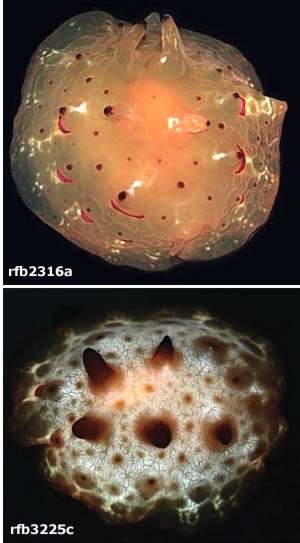
Pleurobranchus mamillatus
Quoy & Gaimard, 1832
Order: NOTASPIDEA
Superfamily: PLEUROBRANCHOIDEA
Family: Pleurobranchidae
DISTRIBUTION
Indo-West Pacific.
PHOTO
Rabaraba, Papua New Guinea, on a sandy bottom in about 70 feet of water. PHOTO: Ray Izumi.
This pleurobranch is similar in shape and colour to the Mediterranean species Pleurobranchus testudinarius (Cantraine, 1841). It is large and tuberculate, often with bright pink or yellow rings encircling the base of each tubercule. It has seldom been reported since Quoy & Gaimard's first report from Mauritius. It has been found in New Caledonia (personal observations), New South Wales, Australia (Allan, 1957), [and possibly from the Great Barrier Reef (Kenny, 1970) and southern Africa (MacNae, 1962)]. It has also been recorded from Kerama Islands, southern Japan as P. grandis by Atsushi Ono (1999).
Reference:
• Quoy, J.R. & Gaimard, J.P. (1832). Voyages de découvertes de l`Astrolabe pendant les annees 1826-1829 sous le commandement de M.J. Dumont d`Urville. Zoologie, 2: 1-686.
Rudman, W.B., 2000 (April 30) Pleurobranchus mamillatus Quoy & Gaimard, 1832. [In] Sea Slug Forum. Australian Museum, Sydney. Available from http://www.seaslugforum.net/find/pleumami
Related messages
Pleurobranchus mamillatus from Lakshadweep, India
April 30, 2010
From: Apte Deepak


Dear Dr. Bill
Got this interesting Pleurobranchus sp along with Pleurobranchus forskalii. Attaching noth the images. Does P. forskalii shows so much colour variation?
Locality: Lakshadweep, 1 m, India, Arabian Sea, 17th April 2010, Coral reef. Length: 75 mm. Photographer: Deepak Apte.
Deepak Apte
spiderconch@gmail.com
Apte, D.A., 2010 (Apr 30) Pleurobranchus mamillatus from Lakshadweep, India. [Message in] Sea Slug Forum. Australian Museum, Sydney. Available from http://www.seaslugforum.net/find/23588Dear Deepak,
Although I would usually expect some pinkish or purplish colour around the base of the tubercles, I am pretty sure these are Pleurobranchus mamillatus rather than P. forskalii. However P. forskalii certainly has colour variants which look much like your animals.
Best wishes,
Bill Rudman
Pleurobranchus mamillatus from South Africa
March 3, 2010
From: Neil Wiltshire

Dear Mr Rudman,
On a recent dive I saw a number of unusual sea slugs which seemed to be from two different species.
Please could you help with their identification (I will send a separate message for the other specimen)z[#23284]
I think they are pleurobranchs, but am not sure of this or the species.
Locality: Unnamed reef near Aliwal Shoal, off Umkomaas, south of Durban, 25 metres, KwaZulu-Natal south coast, South Africa, Indian Ocean, 24 January 2010, Flat sandy bottom, on edge of reef. Length: 150 mm. Photographer: Neil Wiltshire.
Thank you for a wonderful website, and, in anticipation, for your help.
Best regards,
Neil
neilw@fcraft.co.za
Wiltshire, N.I., 2010 (Mar 3) Pleurobranchus mamillatus from South Africa . [Message in] Sea Slug Forum. Australian Museum, Sydney. Available from http://www.seaslugforum.net/find/23283Dear Neil,
This is Pleurobranchus mamillatus. In some specimens there are traces of a pinkish line around the base of the pointed tubercles. It seems to be quite closely related to the Mediterranean species P. testudinarius in which the pinkish line around the tubercles is usually much more prominent.
Best wishes,
Bill Rudman
Juvenile Pleurobranchus mamillatus from Indonesia
March 15, 2007
From: Danny Van Belle

Hi Bill,
I found this crawling through a forest of hydroids.
Can't find it back anywhere !
Can you tell me ?
Locality: Aneka Bagus beach, 12 m, Bali - Indonesia, Indian ocean, 24 august 2006, Sandy area with very few coral blocks. Length: 1 cm. Photographer: Danny van Belle.
Danny van Belle
danny.van.belle@skynet.be
Van Belle, D., 2007 (Mar 15) Juvenile Pleurobranchus mamillatus from Indonesia. [Message in] Sea Slug Forum. Australian Museum, Sydney. Available from http://www.seaslugforum.net/find/19663
Dear Danny,
This is a juvenile Pleurobranchus mamillatus. I feel quite sorry for it - lost like this in a forest of stinging hydroids. As you can see in an earlier message [#10351 ] this seems to be a juvenile color pattern.
Best wishes,
Bill Rudman
Pleurobranchus mamillatus from Indonesia
April 8, 2006
From: Hendra Tan

Dear, Bill
Can U please let me know what the name of this Pleurobranchus is??? I have seen the photo in SEA SLUGS of Western Australia. But I still feel confused about the blue ring colour. While in the book doesn't have it.
Thanks
Locality: Bali, 12 - 15 mtrs, Indonesia, Ocean, 29 October 2005. Length: 5 cm - 7 cm. Photographer: Hendra Tan.
Hendra Tan
hendradive@bdg.centrin.net.id
Tan, H., 2006 (Apr 8) Pleurobranchus mamillatus from Indonesia. [Message in] Sea Slug Forum. Australian Museum, Sydney. Available from http://www.seaslugforum.net/find/16243Dear Hendra,
This is Pleurobranchus mamillatus . There is another a species, Pleurobranchus forskalii, which also has large rings on its back but if present they are white not coloured. Also in this species the rings encircle a large tubercle, which although not obvious in your specimen, make it quite different from P. forskalii
Best wishes,
Bill Rudman
Pleurobranchus mamillatus from Eilat, Israel
February 24, 2006
From: Albert Baranes

Could someone please identify this species for me ?
Locality: Eilat, 5 m, Israel, Red Sea, 21 February 2006, Inside the marina, muddy bottom. Length: 30 cm. Photographer: A. Baranes.
Avi Baranes
avib@vms.huji.ac.il
Baranes, A., 2006 (Feb 24) Pleurobranchus mamillatus from Eilat, Israel. [Message in] Sea Slug Forum. Australian Museum, Sydney. Available from http://www.seaslugforum.net/find/15918
Dear Avi,
This is Pleurobranchus mamillatus. Although none of the tubercles on the back seem very long in yoru photos the pinkish-purple ring around the base of the tubercles is fairly typical of this species.
Best wishes,
Bill Rudman
Pleurobranchus mamillatus from Zanzibar
October 31, 2005
From: Carlos Martínez-Escamilla

Here are some photos of, what is for me, a rare nudibranch? which I saw while diving north-west of Zanzibar, near Bawe Island. I am unable to identify it. What do you think is it? I can find similar looking animals, but nothing as big as this.
Locality: Bawe Island. Zanzibar. Tanzania, Indian Ocean. Depth: 20 m. Length: 45 to 50 cms. August 2005. Observed alive on sandy ground. Photographer: Carlos Marínez-Escamilla
Thank you for your help and your wonderful work helping sea lovers.
Carlos Martinez-Escamilla
Madrid. Spain.
CCME01@teleline.es


Dear Carlos,
Not all sea slugs are nudibranchs. This is a pleurobranch, one of a group of sea slugs which are characterised by having a large gill on the right side of the body, hidden beneath the mantle skirt.
This species is Pleurobranchus mamillatus, which was first decribed from Mauritius in 1832, but has seldom been reported since, so it is good to get another record. It is quite variable in colour and looks very similar to a species from the Mediterranean, P. testudinarius. These very large animals can look quite spectacular on a white sandy bottom. As we can see in your middle left photo, the tubercles on its back are able to extend and contract a considerable distance.
Best wishes,
Bill Rudman
Another form of Pleurobranchus mamillatus
August 22, 2005
From: Dong Bum Koh


Dear Bill,
Concerning the message of Pleurobranchus mamillatus [#13658], I got more photos from my friend. Although they show different color form, I'm pretty sure they are the same species.
Locality: Bum islet. Seogwipo. Jeju. South Korea. Depth: 25 m. Length: Approx.17 cm. 12 July 2005. Muddy. Photographer: Sung Han Cho
Best regards,
Dong Bum Koh
drkoh@seasee.co.kr
Koh, D. B. , 2005 (Aug 22) Another form of Pleurobranchus mamillatus. [Message in] Sea Slug Forum. Australian Museum, Sydney. Available from http://www.seaslugforum.net/find/14601
Dear Koh,
Thanks for these photos. They show the extreme range of colour variation and the amazing tubercles this species has. It certainly has similarities to the Mediterranean P. testudinarius. I have included a close-up alongside that shows the pink rings encircling the base of some tubercles, just as in P. testudinarius.
Best wishes,
Bill Rudman
Pleurobranchus mamillatus from Sth Korea
August 19, 2005
From: Dong Bum Koh

Dear Bill,
I would like introduce Pleurobranchus mamillatus (Quoy & Gaimard, 1832) for your Forum.
Locality: Jeju island. Bum islet, South Korea. Depth: 34 m. Length: 150 mm.
13 June 2004 Sandy bottom . Photographer: Dong Bum Koh
I really don't know how to thank you for all your comments that are very helpful for me.
Best regards,
Dong Bum Koh
drkoh@seasee.co.kr
Koh, D. B. , 2005 (Aug 19) Pleurobranchus mamillatus from Sth Korea. [Message in] Sea Slug Forum. Australian Museum, Sydney. Available from http://www.seaslugforum.net/find/13658Dear Koh,
I have never seen one with this colour pattern, but as Bob Bollands' photos show us [message #2346] this species is very variable in colour pattern.
I am glad you find the Forum useful. I can assure you that your contributions are giving us a valuable insight into the fauna of your country.
Best wishes,
Bill Rudman
Pleurobranchus mamillatus from Indonesia
October 1, 2003
From: Erwin Köhler

Dear Bill,
Attached is one more shot from Sulawesi, Indonesia, divesite "Jahir" by Giorgio Berger, [incocnito@hotmail.com].
At first sight I thought it is a colour variant of Pleurobranchus forskalii, then I noticed the large tubercles and guess now that it is Pleurobranchus mamillatus, but I have not until now seen this colour variant ...
length 22cm
depth 12m
date 03 August 2003
Regards
Erwin
Erwin@Philippine-Sea-Slugs.com
Köhler, E., 2003 (Oct 1) Pleurobranchus mamillatus from Indonesia. [Message in] Sea Slug Forum. Australian Museum, Sydney. Available from http://www.seaslugforum.net/find/10962Thanks Erwin,
Yes this is Pleurobranchus mamillatus. The species it most resembles is the Mediterranean species Pleurobranchus testudinarius. These two species certainly need to be compared in some detail
Best wishes
Bill Rudman
Pleurobranchus mamillatus from Anilao
July 13, 2003
From: Ray Izumi

Here is a photo of what appears to be a Pleurobranchus mammilatus from Anilao [Batangas, Philippine Islands]. It is quite small, about 10mm, found on sandy bottom at night, at 50 ft. depth.
Ray Izumi
izumirm@sprynet.com
Izumi, R., 2003 (Jul 13) Pleurobranchus mamillatus from Anilao. [Message in] Sea Slug Forum. Australian Museum, Sydney. Available from http://www.seaslugforum.net/find/10351Dear Ray,
At such a small size it is sometimes difficult to idenmtify pleurobranchs, but I think you have got this id right.
Best wishes,
Bill Rudman
Pleurobranchus mamillatus? from Japan
May 22, 2003
From: Yoshinori Fukuyo

Dear Bill,
This creature encountered at the 15 meter water depth of the Tsuruga Bay coast in Japan. The size is about 10 centimeters.
I photographed it on March 22nd, 2003. The water temperature is 17 degrees.
Is this a variation of Pleurobranchus mamillatus?
Yoshinori, Fukuyo
fox@vcs.wbs.ne.jp
Fukuyo, Y., 2003 (May 22) Pleurobranchus mamillatus? from Japan. [Message in] Sea Slug Forum. Australian Museum, Sydney. Available from http://www.seaslugforum.net/find/9961Dear Yoshinori,
yes your animal is a colour form of Pleurobranchus mamillatus.
Best wishes,
Bill Rudman
Pleurobranchus mamillatus from Okinawa
May 4, 2000
From: Bob Bolland

Hi Bill,
In response to a recent P. mamillatus post in the Slug Forum, I thought I'd send some images and general information on the Okinawan material.
I found what I believe to be the end of a mass spawning. I found the initial lone animal on 18 February, 1990; on 14 & 15 March, 1990, scores of ova were found in the general area (although no animals were actually seen on the eggs). The accompanying photo is typical of the numerous ova found at this time. Many of the animals appeared to be moribund and were observed to have wounds which appeared to have been predator-inflicted(?). Perhaps as many as 25 animals were seen on the 14th and 15th of March. I've only found a few others since then up to the present time.
All of these animals were seen at one specific dive site, Seragaki, Okinawa; one specimen was found on open sand, all others, including the ova, were found amid mixed sand and strewn coral rubble. The animals were all found within an approximate spread of perhaps fifty meters and a 37m ~ 49m depth range. There was relatively little consistency in color of these attractive animals. The observed colors were a very light gray, mottled gray, light tan, dark brown, and black; many of the individuals had prominent dorsal projecting papillae and all had a consistently brightly colored lunate pattern on the notum.
Slide Data:
D-1702-14: Ova, size not recorded / 37m
rfb2316: 145mm / 43m
rfb3241b: 66mm / 37m
rfb3241c: 77mm, [second animal in photo not measured or collected / 37m]
rfb3225c: 70mm / 47m
Cheers,
Bob
bollandr@rapid-link.ne.jp


Dear Bob,
Thanks for the photos and information. Two general points it raises is 'mass events' such as mass mortality, mass spawning etc., and predation.
We normally associate 'mass events' with Sea Hares but I am sure we all can remember a few occasions when we have witnessed an event such as you describe for P. mamillatus. I can remember in Tanzania on one occasion [lasted about a month] where shallow reef flat was a mass of large Pleurobranchus forskalii. I had never seem them in such numbers before or since. And Scott Johnson's message about Gymnodoris ceylonica reports a similar 'mass' event. I guess the other think to realise is that population explosions like this are commonplace among small sea slugs like sacoglossans, aeolids etc. They only seem special when the animals involved are large.
While mass events in Sea Hares are a fairly normal part of the life cycle, in large pleurobranchs and nudibranchs they seem to be rare events, probably occurring through a lucky combination of normal events.
The other interesting point you raise is possible evidence of predation by something unknown. One big gap in our knowledge is what actually eats Sea Slugs. Except in rare cases such information, where it exists, is published not in the malacological literature, where we would look, but in the literature associated with predator, for example fish biology journals. Another example of mine about Pleurobranchus forskalii in Tanzania, illustrates this problem. In desperation a visiting turtle specialist asked me to look at some strange chitinous plates from the stomach contents of turtles which he had been unable to identify.
They were the jaw plates of large pleurobranchs, probably Pleurobranchus forskalii. This information was published in some report known to turtle biologists but is effectively lost to malacology. I think this is a good time to add a page for predation records where we can gradually accumulate such information on who/what eats sea slugs. any records/observations would be appreciated.
Best wishes,
Bill Rudman.
Re: Pleurobranchus mamillatus from Papua New Guinea
May 3, 2000
From: Ray Izumi
Thanx for the ID. As to accessibility of sampling site, I found this just off the beach on a "featureless" bottom. During six weeks of intensive diving in and around Milne Bay with very experienced muck divers, this was the only encounter. No other divers, including Roger Steene, had ever seen one of these.
I would estimate the size of this little beauty at about 6-7 cm. If anybody is really interested, I took about 10 minutes of digital video from all angles, it being such an interesting creature. Here are all the pertinent details:
Location: Rabaraba, Papua New Guinea
Bottom: Sand and silt
Depth: 70 feet
Time of Day: About 9 PM
Weather: Mostly sunny days, calm at time of photo
Water Temperature: 80 degrees Fahrenheit
Date: 11 April, 2000
izumirm@sprynet.com
Izumi, R., 2000 (May 3) Re: Pleurobranchus mamillatus from Papua New Guinea. [Message in] Sea Slug Forum. Australian Museum, Sydney. Available from http://www.seaslugforum.net/find/2341Dear Ray,
The lack of published records of this species would suggest it is rare but it may just be that it lives in places that collectors don't often visit. A bit like Euselenops luniceps and Kalinga ornata.
I look forward to receiving your video clip which we will make available on the Forum. I had been planning to add some video clips to the Forum so this will be a good one to start with.
Best wishes,
Bill Rudman.
Pleurobranchus mamillatus from Papua New Guinea
May 1, 2000
From: Ray Izumi

I found this Pleurobranch at Rabaraba, Papua New Guinea, on a sandy bottom in about 70 feet of water. Can anyone ID this species?
Ray Izumi
izumirm@sprynet.com
Izumi, R., 2000 (May 1) Pleurobranchus mamillatus from Papua New Guinea. [Message in] Sea Slug Forum. Australian Museum, Sydney. Available from http://www.seaslugforum.net/find/2338Dear Ray,
This is Pleurobranchus mamillatus which is very similar in shape and colour to a Mediterranean species Pleurobranchus testudinarius.
It has not often been recorded since being described in 1832 but that could be because it lives in places not easily or regularly sampled. Can you give us any idea of its size?
Best wishes,
Bill Rudman.
